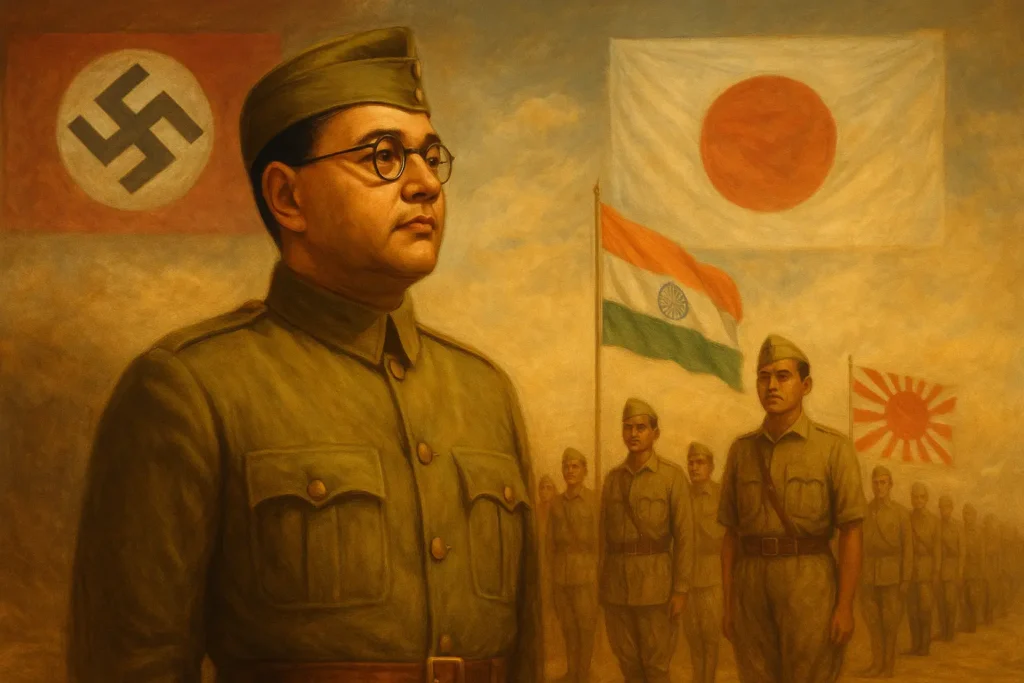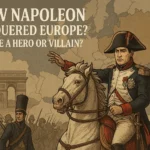Midnight Escape: The Great Jailbreak That Changed History
On a foggy January night in 1941, a man disguised as a Pathan insurance salesman slipped past British guards at his Elgin Road home in Calcutta. His name was Subhas Chandra Bose, and this daring escape would ignite one of the most extraordinary chapters in India’s freedom struggle. Over the next four years, the man the British called “Public Enemy Number One” would forge alliances with both Nazi Germany and Imperial Japan, raise an army of 50,000 soldiers, and establish a provisional government—all while being hunted by every Western intelligence agency.
Chapter 1: The Making of a Revolutionary
Early Years of Defiance
- 1921: Resigned from coveted ICS post (topped exam but refused to serve British)
- 1924: First imprisonment at Mandalay Jail (Burma)
- 1938-39: Elected Congress President twice—defeating Gandhi’s candidate
Controversial Belief: “If blood is to flow, let it be our blood. Give me blood and I will give you freedom!”
The Great Disagreement
| Gandhi’s Approach | Bose’s Approach |
|---|---|
| Non-violence | Armed resistance |
| Gradual reform | Immediate revolution |
| Moral pressure | Military strategy |
By 1939, Bose realized non-violence alone wouldn’t end 200 years of colonial rule.
Chapter 2: The Great Escape – A 6,000-Mile Odyssey
The Elgin Road Jailbreak (Jan 1941)
- Disguised as Muhammad Ziauddin (beard, wire-frame glasses)
- Traveled by car, train, and foot to Peshawar
- Met underground operatives of the Kirti Kisan Party
Daring Journey:
- Peshawar to Kabul (hidden in a merchant caravan)
- Kabul to Moscow (Italian diplomatic passport)
- Moscow to Berlin (April 1941)
“I felt like a hunted animal, but the hunter became the hunted.”
— Bose in a letter to his nephew
Chapter 3: The German Gambit (1941-43)
Strange Bedfellows: Bose and the Third Reich
- Free India Center established in Berlin (Nov 1941)
- Azad Hind Radio launched (German-funded)
- Legion Freies Indien formed (3,000 POW volunteers)
Uncomfortable Truths:
✓ Used Nazi transport to reach Asia
✓ Met Hitler twice (received $1 million equivalent)
✓ Never endorsed Nazi ideology publicly
Propaganda Masterstroke:
Broadcast daily radio messages that reached millions in India:
“This is Subhas Chandra Bose speaking from Berlin…”
Chapter 4: The Dangerous Voyage East (1943)
90-Day Submarine Journey
- U-180 (German) to I-29 (Japanese) near Madagascar
- Only civilian to ever transfer between subs at sea
- Carried gold bullion to fund revolution
Perils Faced:
- Allied patrol planes
- Torpedo attacks
- 60 days confined in steel tube
Chapter 5: The Japanese Phase – Rise of Azad Hind
Forming the Indian National Army (INA)
- 45,000 soldiers (POWs & civilians)
- Rani of Jhansi Regiment (all-women combat unit)
- Provisional Government recognized by 9 nations
Military Campaigns:
- Imphal Offensive (March-July 1944)
- Battle of Kohima (April-June 1944)
- Burma Retreat (1945)
Innovations:
- Jungle warfare tactics
- Mobile radio broadcasts
- Guerrilla supply lines
Chapter 6: The Mysterious Disappearance
August 18, 1945 – The Final Flight
- Said to crash in Taipei (witnesses dispute)
- No body recovered
- British files remain classified until 2045
Conspiracy Theories:
- Escaped to Russia (Stalin’s protection)
- Lived as “Gumnami Baba” in UP
- British secret execution
Chapter 7: The Legacy That Still Burns
Impact on Independence
- INA trials sparked 1946 naval mutiny
- Convinced Britain India couldn’t be held by force
- Inspired future revolutionaries worldwide
Modern Resonance:
- ₹75,00,000 reward (2022) for death documents
- Declassified files reveal Churchill’s personal obsession
- Japanese town maintains memorial shrine
Epilogue: The Flame That Never Dies
Today, as Indians pass the statue of Netaji at India Gate, few realize the full measure of his sacrifice. The man who dared to dream of complete independence when others preached patience, who built an army from prison camps, and whose disappearance remains one of history’s great mysteries—his spirit still whispers in the rustling leaves of the Andaman jungles where his flag once flew free.
Bose proved what one determined Indian could achieve against an empire. His final radio broadcast still echoes across time: “The road to Delhi is the road to freedom. Onward to Delhi!” Though he never reached the capital in his lifetime, his revolution ensured that when freedom came, it was complete and unconditional. The British didn’t leave India—they were pushed out by the force of his uncompromising vision.



